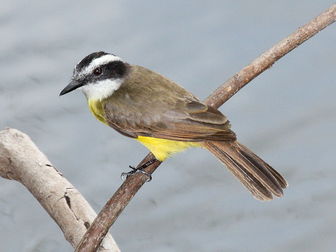Lesser Kiskadee
The Lesser Kiskadee is a species of bird in the Tyrannidae family. It is found in Argentina, Bermuda, Bolivia, Brazil, Colombia, Ecuador, French Guiana, Guyana, Panama, Peru, Suriname, and Venezuela. Its natural habitats are subtropical or tropical moist shrubland and swamps. It is sometimes considered to be in the monotypic genus Philohydor.

Original source: Dominic SheronyPermission(Reusing this file)This image, which was originally posted to Flickr.com, was uploaded to Commons using Flickr upload bot on 20:29, 21 April 2010 (UTC) by Howcheng (talk). On that date it was licensed under the license below. This file is licensed under the Creative Commons Attribution-Share Alike 2.0 Generic license.You are free:to share – to copy, distribute and transmit the work
Author: Dominic SheronyPermission(Reusing this file)This image, which was originally posted to Flickr.com, was uploaded to Commons using Flickr upload bot on 20:29, 21 April 2010 (UTC) by Howcheng (talk). On that date it was licensed under the license below. This file is licensed under the Creative Commons Attribution-Share Alike 2.0 Generic license.You are free:to share – to copy, distribute and transmit the work
The Lesser Kiskadee is classified as Least Concern. Does not qualify for a more at risk category. Widespread and abundant taxa are included in this category.
The Lesser Kiskadee (Pitangus lictor) is a species of bird in the Tyrannidae family. It is found in Argentina, Bermuda, Bolivia, Brazil, Colombia, Ecuador, French Guiana, Guyana, Panama, Peru, Suriname, and Venezuela. Its natural habitats are subtropical or tropical moist shrubland and swamps. It is sometimes considered to be in the monotypic genus Philohydor. References - * BirdLife International 2004. Pitangus lictor. 2006 IUCN Red List of Threatened Species. More
Lesser Kiskadee determination Similar species Tyrannidae Amazonian Royal Flycatcher | Bearded Tachuri | Black-capped Becard | Black-chested Tyrant | Black-crowned Tityra | Black-tailed Tityra | Boat-billed Flycatcher | Boat-billed Tody-Tyrant | Bran-coloured Flycatcher | Brown-crested Flycatcher | Cinereous Becard | Cinereous Mourner | Cinnamon Attila | Cinnamon-crested Spadebill | Cliff Flycatcher | Common Tody-Flycatcher | Double-banded Pygmy-tyrant | Drab Water-Tyrant More
The Lesser Kiskadee, Philohydor lictor, is a flycatcher similar in appearance to the Great Kiskadee but noticeably smaller. BUY IT NOW Go to Purchase Information for explanation of options. More
monotypic as the Lesser Kiskadee may be sparated in Philohydor. It breeds in open woodland with some tall trees, including cultivation and around human habitation, from southern Texas and Mexico south to central Argentina, and on Trinidad. It was introduced to Bermuda in 1957, and to Tobago in about 1970. Description Adult Great Kiskadees are 22 cm (8.7 in) long and weigh 63 g (2.2 oz). The head is black with a strong white eyestripe and a concealed yellow crown stripe. More
monotypic as the Lesser Kiskadee may be sparated in Philohydor. It breeds in open woodland with some tall trees, including cultivation and around human habitation, from southern Texas and Mexico south to central Argentina, and on Trinidad. It was introduced to Bermuda in 1957, and to Tobago in about 1970. More
Family : Tyrannidae
Genus : Pitangus
Species : lictor
Authority : (Lichtenstein, 1823)
